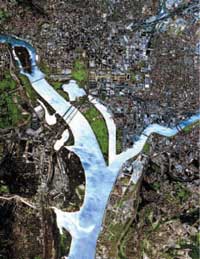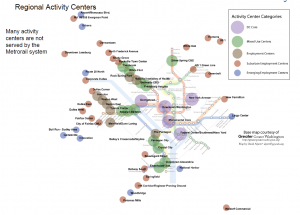Can the Regional Transit System Plan Move the “Region Forward”
Will the regional transit system be up to the challenge of meeting the Transportation Planning Board (TPB) Vision’s objectives and the Greater Washington 2050 Coalition Region Forward’s targets, especially for a higher transit mode share in 2040?
In early 2010, the Metropolitan Washington Council of Governments endorsed Region Forward. It includes goals, objectives and targets for the metropolitan area in 2050, relating to accessibility, sustainability, prosperity and livability. Transportation is one of nine categories among its goals, and the transportation targets draw heavily from the TPB Vision that was adopted in 1998. The Regional Transit System Plan (RTSP) is intended to help develop strategies to achieve Region Forward’s goals, objectives and targets. Several of these targets are focused on transit, and are compatible with the goals of the RTSP. What follows is a listing of Region Forward’s transit-focused goals, and how a future including an implemented RTSP may help achieve them.
Priority for management, performance, maintenance, and safety
This target echoes an objective in the TPB Vision and is intended to insure that investment in existing transportation infrastructure continues as a top priority. For example, Virginia’s funding for roads follows this philosophy, by funding road maintenance and operations off the top of revenues. That philosophy would be advantageous for transit, too, so that investments in new infrastructure wouldn’t result in disinvestment in the existing bus and rail infrastructure that continues to be needed.
RTSP is evaluating an “Enhanced Surface Transit” strategy, in which the network of 24 Metrobus Priority Corridors (PCN’s) are enhanced with bus priority treatments, intended to increase performance of surface transit service in the region while reducing overall operating costs. The RTSP will also look into new surface transit connections with an eye towards interoperability, which would help reduce costs of managing and maintaining different new light rail and streetcar systems.
Connections between Regional Activity Centers
A pair of Region Forward’s targets are for transportation investments to link Regional Activity Centers, and for all of these centers to be transit accessible. Similarly, the TPB Vision calls for a web of multimodal transportation connections between the region’s core and Regional Activity Centers, providing for improved mobility with reduced reliance on the automobile. As shown, these centers are located throughout the region, often in the vicinity of major highways, but sometimes well beyond the reach of Metrorail.
One RTSP strategy is to extend Metrorail service out to many of these outer suburban activity centers. Another RTSP Strategy, considers circumferential transit options to enable suburb-to-suburb transit trips. While we are evaluating these strategies, it will be a major challenge for the regional transit system to be expanded to serve them all in a cost effective manner that would encourage people to rely on transit, rather than automobiles.
Reduced vehicle miles traveled (VMT) per capita
Both the TPB’s Vision and Region Forward target vehicle miles traveled (VMT) per capita for reduction. While transportation and, specifically, alternative modes to driving, are a major factor in reducing VMT, land use is probably more the most important element in reducing VMT. Compact, mixed-use development facilitates the shorter trip lengths that are crucial for enabling walking and bicycling trips, and are advantageous for transit trips. Even when people opt for auto travel on these land-use-facilitated shorter trips, the VMT are reduced, relative to the VMT level with longer auto trips.
RTSP is evaluating the land use in two strategies. The first is the “urban design” strategy, which looks at how fine-grained street networks help increase walkability. The second is the land use component of the TPB’s Aspirations Scenario, which shifts new growth of jobs and households into the region’s activity centers. Hopefully, these land-use-oriented strategies can help reduce regional VMT, which is one of about a dozen measures of effectiveness being evaluated in the development of the RTSP. (link to TAG Meeting #2 presentation, last slide?).
Increased share of walk, bike and transit trips
Echoing the TPB’s Vision, Region Forward calls for an increased share of travel by walking, bicycling and transit. Whether that means an increased share for each of the three, or increased share for the total of the three, this is an ambitious target as the region continues to grow outward, as planned. Another of the Regional Transit System Plan’s measures of effectiveness is transit mode share.
This pattern of planned development is forecast to result in about three quarters of the growth in travel for work trips (about 1.2 million of the additional 1.6 million work trips between by 2040) to be suburb-to-suburb, for which transit travel is often difficult. Because of this growth pattern, transit shares of individual travel markets must increase just to keep the overall transit share from declining. To illustrate that, for the journey to work into the DC/Arlington core, today, transit attracts an estimated 63-percent of this market. This market will grow by 2040 but not by a lot. At the other extreme is non-work travel in the outer suburbs, where the current transit share is practically zero, and the 2040 forecast growth in this market is tremendous. Unless the transit share for one or both of these markets were to increase significantly, the transit share of the total of the two markets would decrease.
RTSP is looking to land use strategies, described above, to work towards increased bike and walk mode shares. Several transit strategies are aiming to evaluate expanded transit capacity to the core as well as the suburban activity centers. New heavy rail lines through the core have been evaluated, and many strategies include new or expanded suburban surface transit.
The study team working on the Regional Transit System Plan is evaluating these strategies and many more, first in isolation. In the coming months, strategies will be combined into scenarios and evaluated for their synergistic effects on the measures of effectiveness, including those mentioned above. We hope to find a combination of strategies that can satisfy all of our region’s goals. What set of strategies would you like to see evaluated?




Great write up! As part of the Region Forward baseline analysis we are examining regional activity centers that have higher street grid densities throughout the region for the first time. There’s been a lot of research showing higher street grid densities support alternative transportation choice such as transit, walking and biking. We are just now starting to get some really exciting information on some of these centers. It will be interesting to see how the RTSP links some of these activity centers that have the land use and street grid density to really move the needle on these other regional goals like VMT reduction, and increased walk bike trips. Nice article!
Dear Sirs/Madams:
I can’t phatom why the Greenbelt West station has not been fast-tracked for commerical. residential and retail use. Also, I don’t understand why the Greenbelt Station does not have a parking garage were the customers are not expose to adverse elements when trying to access the station. Thus, when I look at the profile of individuals that make this elementary observation a reality, one may consider the source. I don’t believe this is rocket science, however deliberate self-serving attempts to secure one’s paycheck. Get busy people America needs you and by 2050 your children and grandchildren are going to beg the question, what were they thinking and why don’t they care about me.
Dear Sirs/Madams:
I can’t phatom why the Greenbelt West station has not been fast-tracked for commerical. residential and retail use. Also, I don’t understand why the Greenbelt Station does not have a parking garage were the customers are not expose to adverse elements when trying to access the station. Thus, when I look at the profiles of individuals that could make this elementary observation a reality, one may consider the source. I don’t believe this is rocket science, however an deliberate self-serving attempt to secure one’s paycheck. Get busy people America needs you and by 2050 your children and grandchildren are going to beg the question, what was my grandparents thinking and why don’t they care about me. I have an Initial Innovative and Strategic Plan for WMATA in order to expedite matters. Let’s call it, The Rollup Your Sleeves Initiative, Phase I, Phase II and Phase II project for the people.